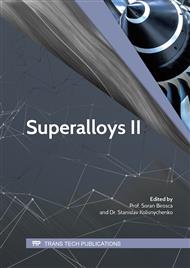p.113
p.121
p.127
p.135
p.142
p.151
p.163
p.169
p.182
Thermal Deformation Behavior and Formability of High Temperature with Corrosion Resistance Alloy
Abstract:
The aim of present wor is, therfore, to investigated the effect of the damage value prediction equation on the formability of compression specimen and find the optimize forming condition.Although Inconel 625 alloys are excellent materials, Ni-base alloy cannot be formed at room temperature owing to limitation of formability. To improve the formability of Inconel 625, it is necessary to investigate the formability at a high temperature range.A high temperature compression test is performed with a Gleeble 3500 testing machine at various temperatures (approximately 900 1200°C) and strain rates (10/s and 30/s) to obtain high temperature deformation characteristics of Inconel 625. Furthermore, high temperature tensile tests results are used to measure elongations and reductions in the area of Inconel 625.A rigid-plastic finite element simulation is applied to the high temperature compression process to obtain the damage valueThe results of the hot deformation experiment and analysis are presented for various conditions of temperatures and strain rates, and it is expected that damage value will be used in hot forming processes such as hot extrusion and rolling process.
Info:
Periodical:
Pages:
142-150
Citation:
Online since:
February 2019
Authors:
Price:
Сopyright:
© 2019 Trans Tech Publications Ltd. All Rights Reserved
Share:
Citation:



